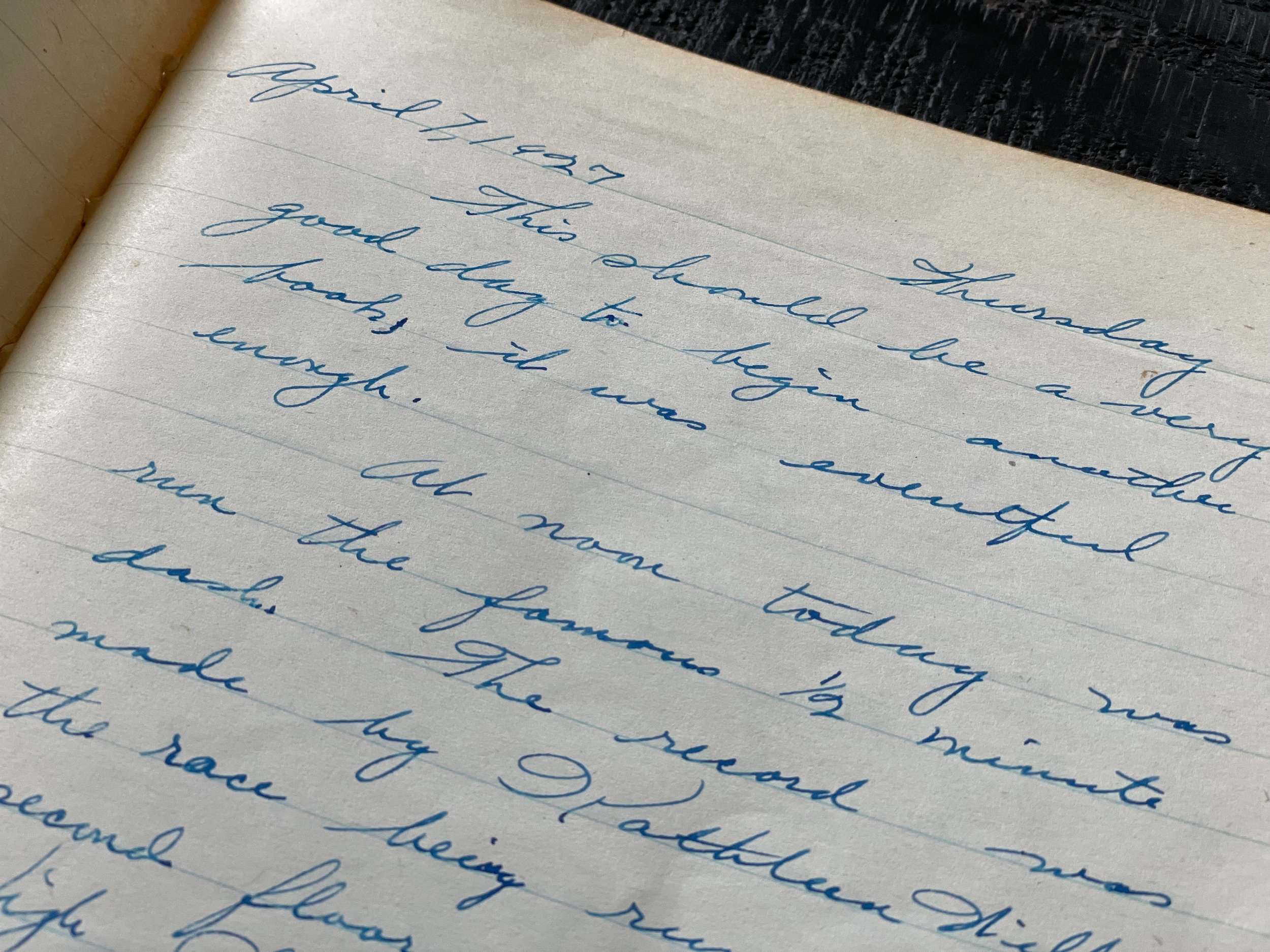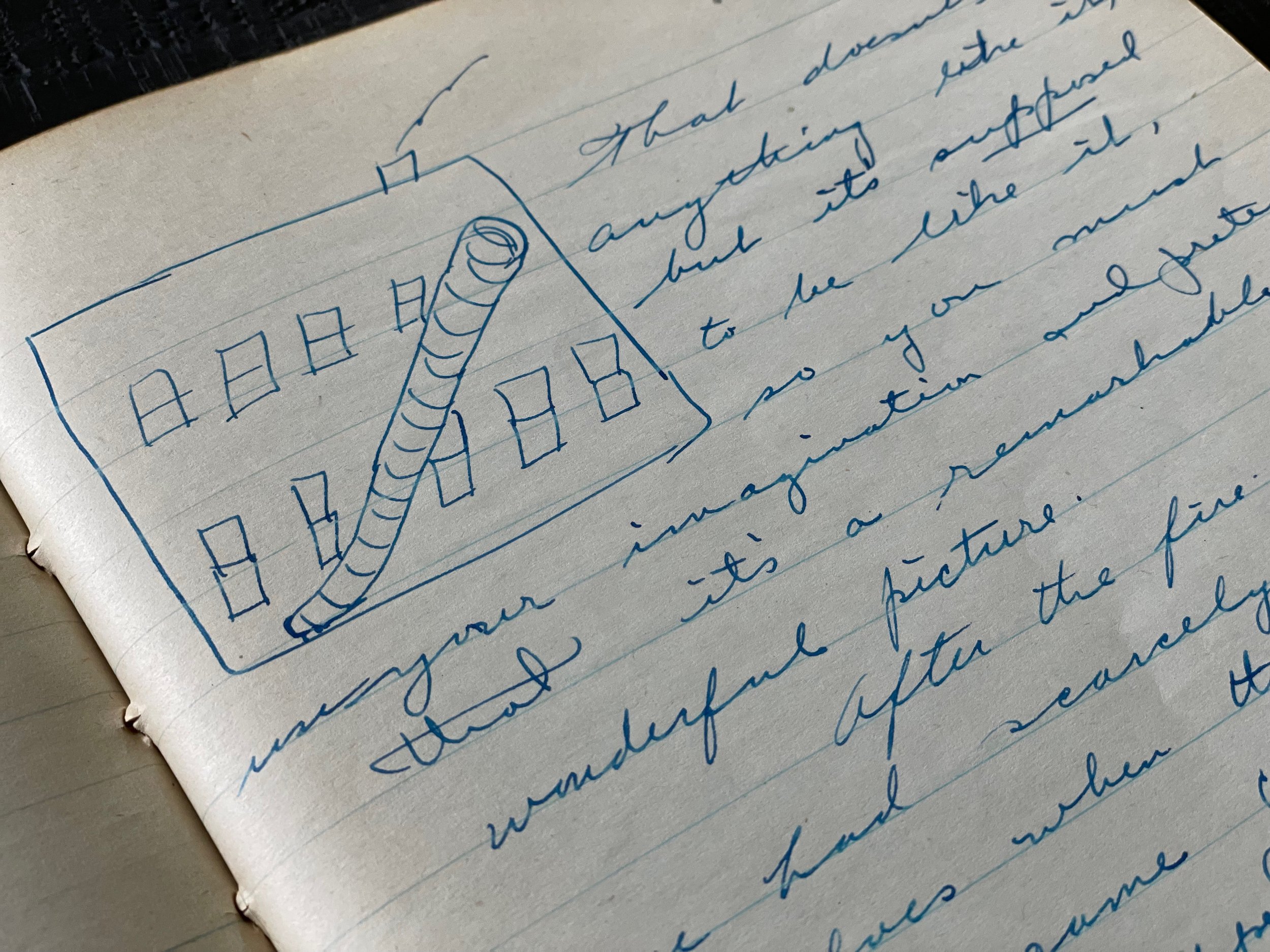Kathleen Willard
Kathleen Lucille Willard (1910-1992) lived in Saginaw, Michigan, and was 17 years old when she wrote her diary in 1927. She was a junior at Saginaw High School and lived with her mother and sister. Kathleen was a born storyteller and her diary captured her adventurous, happy, and humorously self-deprecating voice, creating a vivid picture of the excitement of late girlhood that transcends generations.
Downtown Saginaw, 1930
Introduction
Saginaw is right in the middle of the state of Michigan, and close to Lake Huron in the “thumb joint” that is the mythical “mitten” of the state. The name is believed to mean “place of the outlet” in Ojibew. The state is home to many Indigneous nations that make up the Anishinaabe, including the Ojibew (Chippewa), Odawa (Ottowa), and Potawatomi (Bode’wadmi), many of whom currently live in Michigan. It was originally the location of a fort around 1816, after French missionaries established a trading post there. This industrial city was a major lumber producer in the 19th century, and then became a major manufacturing center in the 20th. During the manufacturing downturn of the late 1900’s, however, unemployment and crime rose and the population declined. In the late 1920’s when Kathleen wrote her diary, the population was approaching 80,000, but just 44,202 people lived there in the 2020 census.
Kathleen was born to Harry Lee (1888-1964) and Ella Margaret (Mahr, 1890-1979) on February 26th, 1910. Harry and Ella were both originally from the Saginaw area; he was one of five children and she was one of at least three. He was a barber and worked in this profession for his whole life. The two were married on August 4th, 1909, and Kathleen was born just six months later. She would be followed by her little sister, Pauline Alice (1915-1982), five years after that. The marriage didn’t last, though, and the two were divorced in May of 1919, with Ella citing “extreme cruelty and drunkenness” as the causes for divorce. By the time we meet Kathleen, Harry has moved to Cambridge, Massachusetts, gotten remarried to a woman named Martha (Nemode, 1891-?), and had two sons with her there. Interestingly, Ella is listed as “widowed” on the 1920 census despite Harry being very much alive in Massachusetts, and she was working as a “Saleslady” in a washing machine store. Kathleen never mentions her father in the diary nor any of his family.
I don’t know much about Ella’s family; her parents were immigrants from Germany, and I wonder if that has anything to do with the absence of information. Part of the problem is that their last name is spelled differently in different records, making the family difficult to trace through time. Her parents were Alice (Merrick, I think 1868-1938) and Anthony Mahr (?-?). She had at least two younger brothers, Harry Stanley (1890-?) and Edwin Patrick (1896-1961), but I really only knew to look for them because Kathleen mentions them in the diary.
Kathleen Willard’s yearbook photo from her senior year of high school, 1928
In 1927, Kathleen was happily living in Saginaw with her mother and Pauline. Ella’s family is involved in the girls’ lives, and Kathleen loves school, is a high-achieving student, has many friends, and is in the French Club. When the Diary opens, Kathleen is in the last few months of her junior year of high school.
The Diary
Kathleen’s diary is written in a regular, wide-ruled notebook, perfectly emblematic of a high school girl. It is in shockingly good shape for how fragile the notebook is; its cover is just made of cardstock, but it looks like it could have just come off of Kathleen’s desk. She notes at the end of the diary that she is moving onto her eighth book since starting high school, so this one must be her seventh. She signed the front cover and the first page with her name and the name of her high school. Many Diary Writers sign their diaries and often include their city under their names. Kathleen loved her high school and spent a lot of time there after school and at events on evenings and weekends, so it is fitting that she wrote its name in the place that many people write where they live. Fortunately, I was able to find a copy of her high school yearbook from 1927 and the year after when she was a senior to help me with this story.
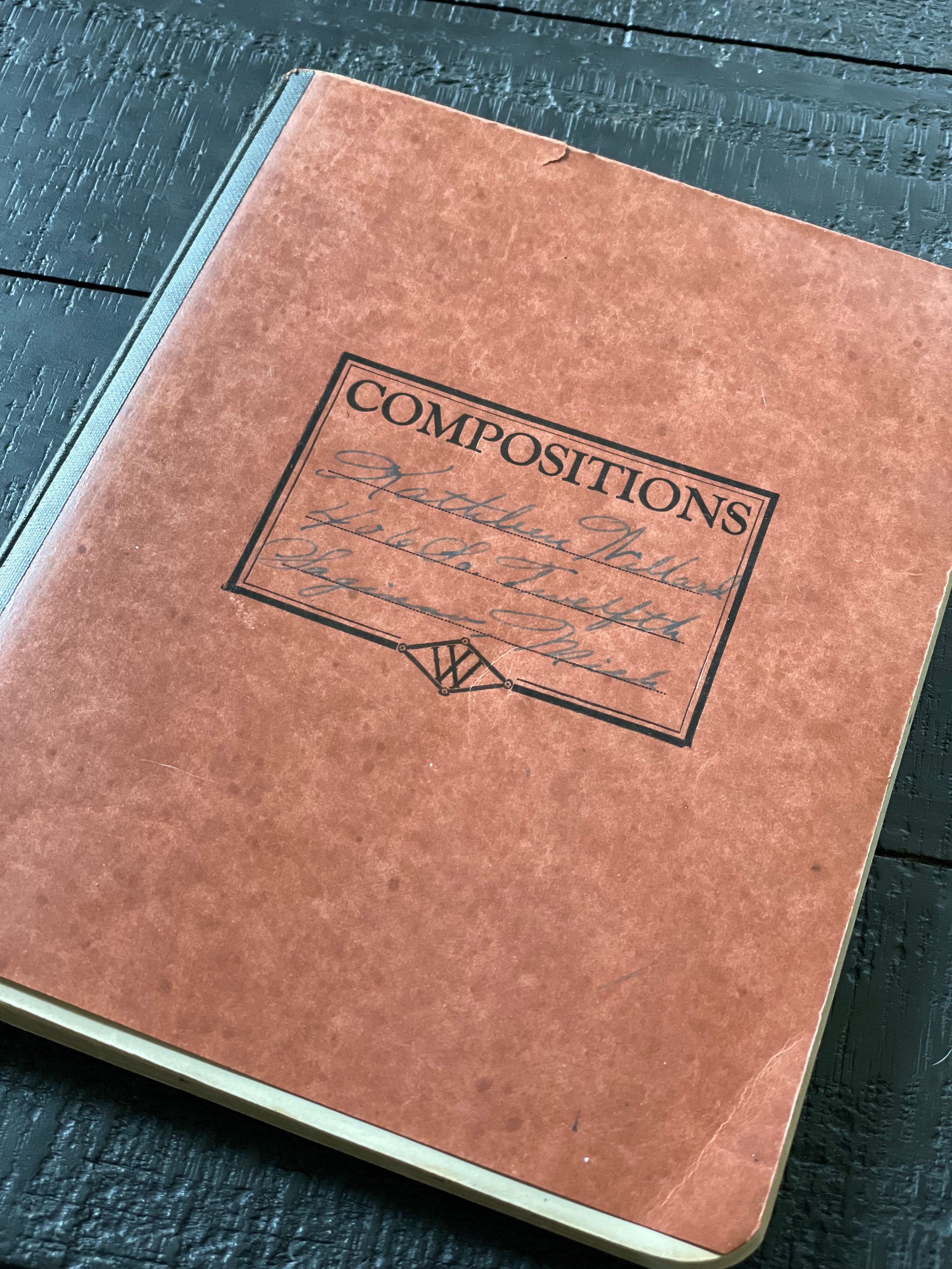
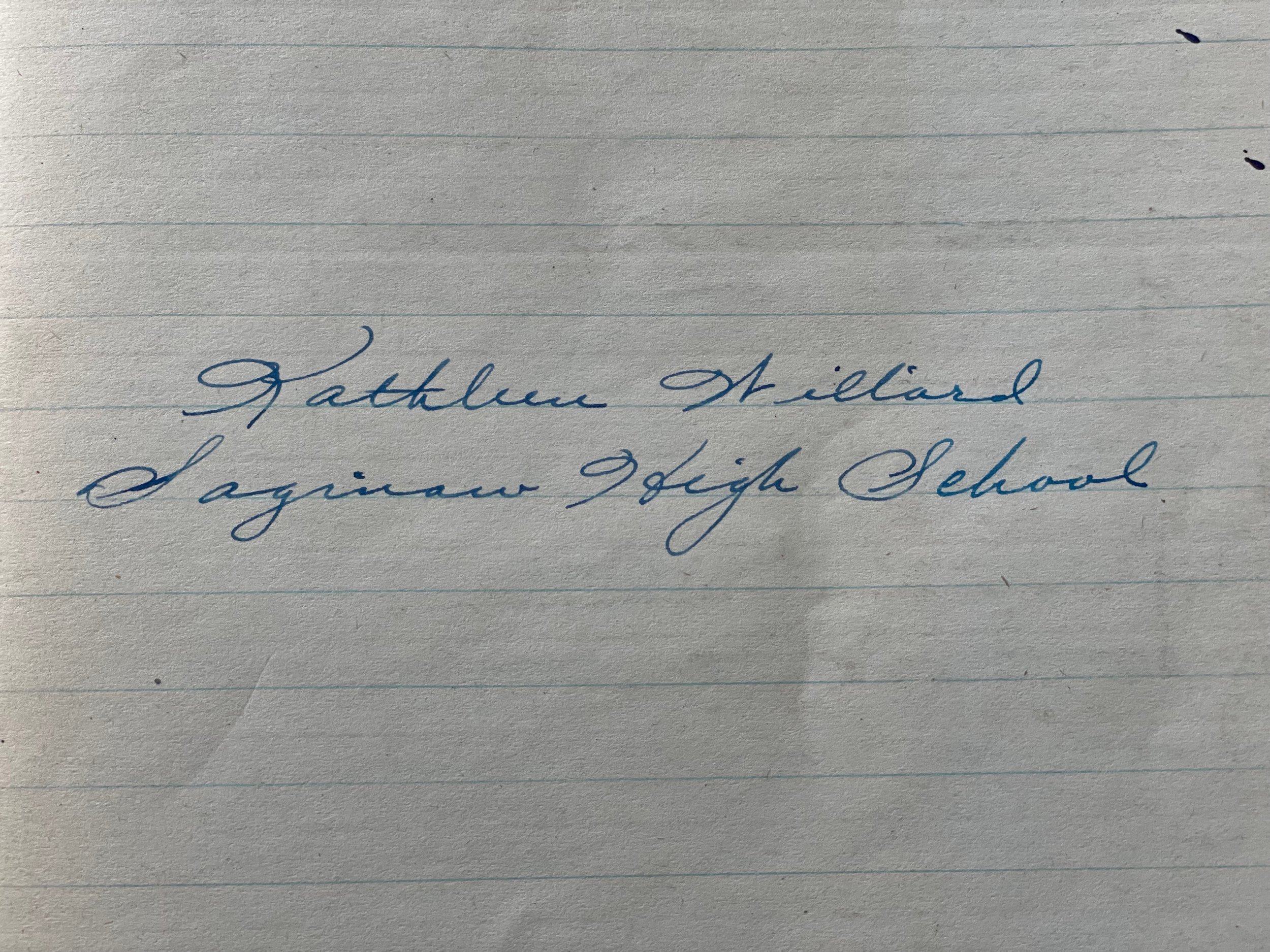
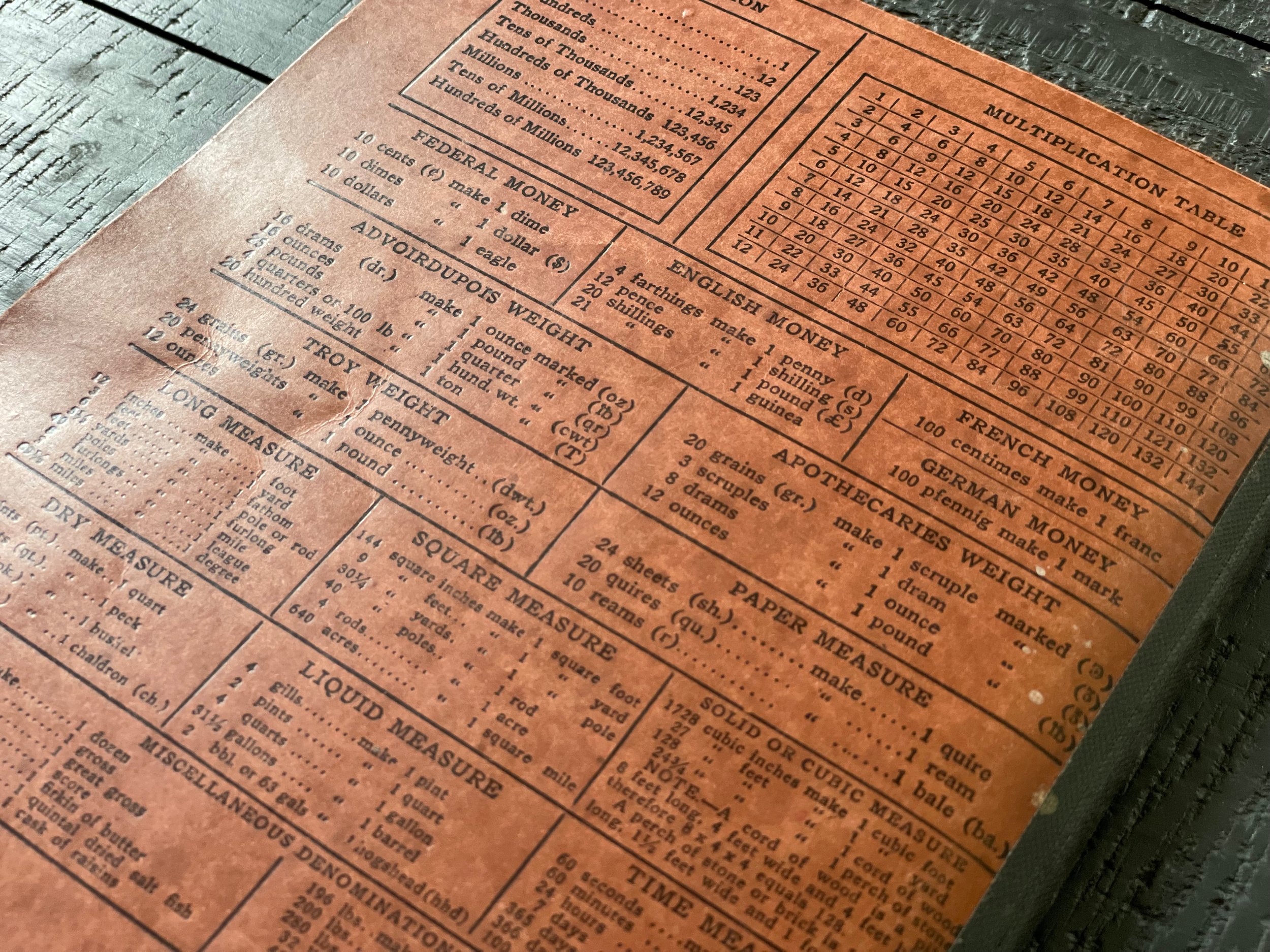
Most of the time when I write the narratives for diaries, my mission is to take the daily entries and create a story of the writer’s life. In this case, Kathleen is a better storyteller than I could ever hope to be! Every entry is a short story, many of which could stand by themselves. While she often gives a full account of her day, she also often picks one event, one few-minute moment from her day, and tells the expansive story of that moment with descriptive language, humor, and well-written prose. Kathleen writes about her days as if she is a star and the diary is a screenplay for the movie of her life! I always post a transcript of each diary, not so much because Readers should read it, but more for the sake of research and so that I can totally share the diaries with you. This time, I would encourage you to read Kathleen’s transcript! I will tell the story of Kathleen’s few months from the diary below as I always do, but I will never be able to capture the whimsy and unique voice that Kathleen’s actual entries have.
Kathleen is smart, hard-working, funny, kind, and adventurous. Reading her diary was a celebration of girlhood, and Kathleen often creates celebrations for herself and the people in her life. She longs to travel, loves to swim, and has deep friendships with her family, girlfriends, and teachers for whom she has genuine care and love. She creates bonding moments- she and her friends write secret notes to each other and decide on a mutual time to open them in the middle of the night; she plans and facilitates surprises for people she cares about- she threw an elaborate Easter celebration for her mother and sister and played a trick on her favorite teacher that involved Kathleen showing up at the teacher’s home in costume; and she is actively engaged in the world around her- she notes the blooming of flowers and the nature of stars in the sky, interacts freely with children and animals, and takes advantage of opportunities to achieve at school. Reading Kathleen’s diary made me remember what it was like to be 17 and the joy that I experienced then too.
The diary only covers the dates of April 7th-July 16th, 1927. Kathleen uses blank notebooks for her Diaries, so she just picks up a new one when the last one runs out. Right away in the first entry, we are in it- Kathleen tells the story of “the famous ½ minute dash”, which she sets the record for, and a trip with her friend, Julia, to a lecture from a “parent-child counselor.” As the girls waited for the bus to take them home, the lecturer came out to wait for a car and the girls seized this opportunity. Kathleen asked him if he had a message for the students of Saginaw High School, and he said, “that he sent his love, his faith, and his hope, and for us all to live by our dreams and to make life a big adventure, for we have more of dreams and ideals than the grown people.” The girls then had a sleepover at Kathleen’s house and they “talked until she [Julia] fell asleep.”
I love her dry humor! Some of my favorite examples:
Sunday, April 10th: “Gaze upon a budding angel. I did dishes three times today. Don’t worry, I shan't do dishes for a few days now to make up. The fact remains, though, that I did them. I still feel rather dazed and unnatural, but that soon will be worn off and I’ll be the same as ever.”
Wednesday April 13, 1927: “Miss Finlay says that I do more arguing than any girl she ever knew. How delightful it is to be appreciated.”
Saturday April 23, 1927: “I believe that I forgot to tell that spring is here officially now. Miss Burnham has changed from high shoes to oxfords, so we may all hang away the winter wraps.”
Next comes the saga of the school fire alarm. Do you remember how exciting fire drills were? The thrill of surprise when the alarm went off, the deviation from the same old routine, getting to meet up and chat with friends outside, returning to class with just a few minutes of the class left, and best of all, when the fire engines actually came?! All this is made better in Kathleen’s story because her school uses slides as fire escapes- Kathleen even draws what they look like in the diary.
Monday April 11, 1927
Such excitement this morning. We had scarcely begun our English work when the fire bell rang and we had a fire drill. Some of those having class on the second floor used the near fire escapes and it was worth a good deal to watch the people come sailing out. Some sailed too well and landed none too gently, and there were some skinned elbows and knees. You see, the fire escapes are like slides somewhat, only more like a round tube.
(Drawn picture)
That doesn’t look anything like it, but it’s supposed to be like it, so you must use your imagination and pretend that it’s a remarkably wonderful picture.
Even BETTER, the school then announced that they would open the fire escapes at noon and at night for a week so that students can practice using them! What? Can you imagine a school doing this today? Kathleen tried the fire escape on Wednesday and Thursday that week and reported her outstanding success in her diary. She also said that on Wednesday, April 13th, they took their pictures for the yearbook; it’s fun to have that picture today and to read about her experience of having it taken, “I gave my best rendition of the correct expression for sea sick scarecrows and evoked much applause from the envious photographer.”
After describing her second trip down the fire escape, Kathleen tells the story of a night two years before that she shared with her friend, Anna. At the time, Anna was living farther away, but had come to Kathleen’s house to spend the night. They created a celebration out of it and the two feasted, talked, and stayed up all night, as teenage girls do. In present day 1927, Anna now lives in Saginaw and goes to school with Kathleen, so they plan to celebrate the anniversary of the first celebration by having another sleepover. I love this about Kathleen- she invents reasons to celebrate with her friends and family often, and fondly remembers these events for years after. Another example is when Miss Brooks has a birthday. Kathleen writes in red ink that day because it “is a red letter day,” and she gave Miss Brooks a book of poems as a birthday gift.
By mid-April, Kathleen started to get ready for Easter. This is another opportunity for celebration, so of course Kathleen would take advantage! She bought Easter baskets for her mother and sister filled with candy, flowers, and eggs, and hid them so that her family could search. Then, Kathleen decided to surprise her favorite teacher, Miss Brooks, too. She dressed up as an old man, fake mustache and all, and brought a basket to the house that Miss Brooks lived in. She left the basket with the landlady, and Miss Brooks would enlist another teacher to tease Kathleen in the days to come about who the old man could have been that brought her an Easter basket.



Kathleen’s high school offers classes in practical skills, in addition to the regular academic subjects. Kathleen takes English, French, Stenography, Typing, Sewing, and Bookkeeping. She works hard in school, loves her teachers, and gets great grades. Sewing seems to be her least favorite subject, or at least the subject that she lacks confidence in. On April 20th, she finished her pajama assignment for class. They were for her sister, and the next project that she is assigned is a dress for herself. Kathleen often comments on the grades that she gets in class and what she received on her report card. Her report card grades are all As and Bs, but she is always striving for better.
Friday April 29, 1927
Marvelous for me, dearie! I actually had 100 on an English test. The only one in the class too.
Only A on my French theme, though. Going down. All because of my own stupidity, too. I didn’t stop to think of the present indicative of dormir and calmly wrote the past definite. Ignorance can go no further. Stay me not, I must to the river to drown myself and my nonsense.
Kathleen is clearly an extrovert. She is always busy going to events, seeing friends and family, and dreaming of traveling. On Friday, April 22nd, she and her sister go to the Junior play. Kathleen and Pauline are very close and spend time together as friends, despite Pauline being five years younger. It seems like her two closest girlfriends were Anna and Julia and the girls spend lots of weekend nights sleeping over at each other’s houses and staying up into the wee hours of the morning talking. The Willards are friends with other families too- the La Fontaine’s, the Shaddeau’s, The Sarles, and the Teysen’s- and the families spend time together often. Ella’s family also visits. On Mother’s Day, Ella’s mother, Alice, came over to take “a ride” with them and later in the diary, Ella’s brother and his family visits. Kathleen also takes every opportunity to chat with people around town, including children.
Thursday May 5, 1927
I like to wear my red hat with the cherries when I am around children, for they all like it. Today on the street I spoke to a couple of littchildren (new speed writing for “little children”). One of them stepped up to me, after a whispered consultation with the other, and shyly asked if my “grapes” were real. He was adorable, and then I wished that they were real so that he might have some.
On May 10th, Kathleen mentioned that they took a test in French class to see who would go to Mount Pleasant “for the exams.” The next day, Kathleen was so excited to report that it would be her and Julia going together. I don’t know what this contest is exactly, but on May 20th, Kathleen, Julia, and a bus full of their classmates loaded up at 6am and went to a college in Mount Pleasant. Although Kathleen doesn’t give the name, Mount Pleasant is home to Central Michigan University, and I think it must have been there. She competed in French, but other students went to compete in a variety of other subjects as well. Even though it is just a one-day trip, Kathleen uses many pages to describe every detail.
When they arrived at the college, they met the rest of the contestants in the gym, all 1,086 of them. This was a huge event! Students split up into their subjects and Kathleen was given a five-page French test to complete. She doesn’t say much about the test, and actually asks the diary to “please let’s pass it over quickly” in the telling of the story.
Mount Pleasant Indian Industrial Boarding School, 1910
Afterwards, the students visited the Mount Pleasant Indian Industrial Boarding School. Schools of this kind were established by an act of Congress in 1819, The Indian Civilization Act, that allocated funds for off-reservation boarding schools to educate… nope, assimilate Indigenous children into White society and norms by taking them away from their families and communities, changing their names and clothes, cutting their hair, teaching them to speak English, and immersing them in White culture. These schools were often run by both the government and Christian missions. This school was part of the same ideology and programming that the more famous Carlisle Indian Industrial School was. Its founder, Richard Henry Pratt, famously said, “Kill the Indian, save the man.” Truthfully, they were one part of the gigantic machine of the colonization of land, people, and minds, playing the part of a school.
This school in Mount Pleasant started as a small school operated by a mission of the United Methodist Church. Indeed, the Grand Chaplin was there on the first day of construction to lead the crowd in a Christian prayer. Construction was finished on the first building in January of 1893, and as the student population rose so quickly after, that an additional 10 buildings were built to accommodate them. There were boy’s and girl’s dormitories, a hospital, a woodworking and blacksmith shop, classrooms, a dining hall, a clubhouse, and several farming buildings. Children from all over Michigan, Minnesota, Wisconsin, and New York were brought to the school and it had an average enrollment of 300 students annually for many years. Children in grades K-8 had a strict and structured schedule of vocational and religious training, including classes in the English language, woodworking, farming, sewing, laundry and housekeeping, all with coursework teaching students how to adapt to White culture. Accusations of abuse and the deaths of children were common at schools like this in the US and Canada, and these schools have recently come into the national consciousness as needing more study to understand the history and lasting damage that they inflicted on Indigenous peoples.
Mount Pleasant Indian Industrial Boarding School, 2018
The school closed in June of 1934 and ownership of the property was transferred from the federal government to the State of Michigan to be used by the Michigan Department of Mental Health to house and teach men with disabilities. The quantities and qualities of abuse that existed in those buildings over time are unthinkable. It was officially closed in 2008 due to budget issues and a decreasing number of patients. The buildings were abandoned and vacant for many years, but are now the property of the Saginaw Chippewa Tribal Nation. They plan to make the grounds into a museum.
Obviously, this visit is obtuse at best, sad and exploitative at worst, based on our current understanding and standards of today. The principal of the boarding school was a former teacher of a teacher at Kathleen’s school, and if I’m giving them the benefit of the doubt, I suppose they could have thought that this was a valuable learning experience for the high school students. They most certainly didn’t explain the school in the way that we would now. Kathleen described visiting the small children and observing them practicing for their commencement day. She sweetly describes some of the children that she remembered from the day and says how much she liked them. For someone who loved and valued her own community and family so much, how did she not wonder about their families too? I don’t judge Kathleen harshly, though. She was a child herself under the care of adult educators and, as I said, I’m sure she was denied knowing the larger context of what she was witnessing.
Anyway, after returning to the college, the students eat, pick flowers, and kill some time waiting for everyone’s tests to be complete. By five, they were back on the bus and headed for home. The bus stopped for candy at some point along the way, and Kathleen described the students as “silly” on the way home. When she returned, she recorded the whole day in the diary, ending with, “I had a very nice time today, and I wouldn’t have missed going for anything.”
The next day, Kathleen learned how she did in the contest:
Saturday May 21, 1927
Don’t faint; I have a little news for you. I won third place in the French contest yesterday. That doesn’t seem like very much, but when I think of the words they asked us that we had not had, it seems more like a miracle. Our school had fifteen points. That gives us fourth place for the state… Mother read in the paper tonight the account of it all.
Fourth place in the state sounds great! On that Monday, the students that had attended the competition met with the Student Council and the ones that won prizes received them.
Life then gets back to normal- Miss Brooks visited Kathleen and Pauline for dinner one night and naps on the couch while the girls prepared it, Kathleen received a bouquet of flowers from a friend and promptly gives them away to Ella, Pauline, Miss Riggs, and Miss Brooks commenting, “Anyway, for two days I’ve had a tulip to wear, so it was someone else's turn; four can gain more good from a bouquet than one can,” and Kathleen stays at school late to work on her dress for Sewing class. Ella’s brother, Harry, and his family visited the Willards on May 28th. Kathleen talked lovingly about her little cousin, Charlotte Marie- “The baby is one dear little sugar lump.”- and cherished the time with her aunt and uncle.
By June 1st, the school year is winding down and Kathleen isn’t happy about it, both because she loves school and because that means it is time for final exams. On Monday, June 8th, her exams began and she received her yearbook- the yearbook from which I was able to get so many pictures and names of the people in this story. By Friday, all of the final exams are done and the high school put on the “Style Show,” to showcase all the work from the Clothing and Sewing classes. Kathleen was the announcer for the event and included the program in the diary. Monday, June 13th, was the last day of school for Kathleen.
With the arrival of summer, Kathleen’s family starts to spend lots of time outside and she often commented about how green and beautiful everything is. They go on picnics and walks, pick wildflowers, carve boats out of wood to sail on water, play games, and go skating. Kathleen and Pauline often go to the library and Kathleen bought some books as gifts:
Tuesday June 14, 1927
This noon I went shopping. I bought three books for gifts. I do so like to do that. It makes me feel so nice all inside.
I like Swinton’s Book Store. Mr. Swinton knows good books, and he loves them. He keeps the store because he loves books. Just think, he has over five thousand books of his own, in his home.
I should like to own a book store. I would have such a nice one. It would please all the nice people, but old cantankerous people wouldn’t like it one bit, and I wouldn’t want them to.
Tonight again Pauline and I took a walk, went skating, and then had a jumping match. We will be good at it sometime, maybe.
One of these books went to Lorna La Fontaine, who graduated on June 15th. Kathleen was pleased to see her friend graduate and gave her a copy of A Tale of Two Cities. She commented that it was the first book that Lorna had ever owned, and how happy that made Kathleen feel to be able to give it to her.
Kathleen’s favorite thing (other than school, all her friends, her family, flowers, children, dogs, writing, giving gifts, creating celebrations, skating, etc.) was swimming and she starts begging her mother to take her as soon as the weather is warm enough.
Monday June 20, 1927
Ha! At last we are having weather warm enough for swimming - we didn’t go swimming. though. Honestly, it doesn’t seem as if I couldn’t possibly wait much longer, though. Everytime I see a pail of water I begin to bellow and sob and cry for a swim. Soon I shall walk to Bay City for a swim. Then everyone will be sorry that they didn’t take me.
On June 26th, the Willards visit the Sarle family at their private beach and Kathleen is finally able to swim. Kathleen swims as much as she can in the days that follow. She even buys a new swimsuit and her grandmother joins the girls as Kilarney beach for a swim too.
The last major event that Kathleen includes in this dairy was a camping trip that Ella, Kathleen, and Pauline took over a long weekend at Mackinaw. The girls take lots of walks together, play on the swings at a playground, visit family friends, and of course, swim. This is how the last summer days of the diary progress- visiting Lorna and other friends and late night drives to cool down from the summer heat. On July 12th, Kathleen says that Ella and Mr. Roberts has taken up golf and even Pauline is playing now (more about Mr. Roberts below). On July 16th, after recounting a sweet visit that she had with Julia, Kathleen concludes the diary, “And so, my friend, I bid thee adieu, and hasten on to my eighth book since I started Saginaw High School two years ago. Farewell!”
After
Just a few months after the diary ends, Kathleen’s mother, Ella, married “Mr. Roberts” on November 9th, 1927. Elmer Roberts (1887-1977) was born in Franklin, Illinois, and had been previously married as well, before serving in WWI. After returning from the war, he and his wife moved to Saginaw, but were divorced soon after in 1919 because of “extreme cruelty.” It makes me wonder if the war had affected him? Before and after the war, he worked in shoe stores, first in Illinois as a Salesman, then in Saginaw as a Manager and, by 1930, he was a District Manager at the R&H Shoe Store.
Kathleen completed her senior year of high school and graduated in 1928. She had a job as a bookkeeper in Elmer’s shoe store the next year. In 1932, Elmer and Ella welcomed their daughter, Nancy Sue (1932-2014). In 1940, Kathleen, Ella, Elmer, and Nancy were still living together. In 1946, Kathleen was a Comptometer Operator for Chevrolet. A Comptometer was the first commercially successful mechanical calculator, so it seems that Kathleen continued to develop her skills to keep up with technology. In 1930, Ella wasn’t employed, but by 1940 she was back at work as a Saleslady in a dress shop.
Pauline graduated from Saginaw High School and married Gilbert Otto (1908-1988) in 1938. He was a lawyer in Saginaw. Pauline, although she had been married two years before, was also listed as a Saleslady in a dress shop, and I wonder if Ella and Pauline were working together. Pauline, who started to go by “Paula” sometime in adulthood, and Otto had their only child, Penelope (1941-2010) on December 23rd, 1941. There isn’t much information about Pauline after that. She died in Saginaw in 1982 and Gilbert followed in 1988.
Nancy married Earl Loeffler in 1951; Earl is described as her “soul mate” in her obituary and they were married for 63 years. In 1957, they moved to Akron, Ohio, and in 1970, they moved to Rome for 5 years. They had four children and Nancy died in Ohio in 2014.
Elmer was the Manager of the R&H Shoe store until at least 1950. By 1952, he was retired and he and Ella moved to Boca Raton, Florida, sometime between 1953 and his death in 1977. Ella died just two years later in 1979. I’m not sure when, but Kathleen moved to Boca Raton as well, perhaps when Elmer and Ella did. She never married or had children, and it seems that her family- Ella, Elmer, and her sisters, Pauline, and Nancy- continued to mean a great deal to her throughout her life. With the few clues we have, this seems to be the case- Pauline and she had a sweet friendship as described in the diary, Elmer gave Kathleen her first job after high school in his store and then, years later, the three moved to Florida together. Lastly Nancy’s obituary reads, “Nancy was greeted in heaven by her parents; and her sisters, Kathleen and Paula.” Kathleen died in Boca Raton on August 28th, 1992.


![Ancestry.com. U.S., School Yearbooks, 1900-1999 [database on-line]. Lehi, UT, USA: Ancestry.com Operations, Inc., 2010.](https://images.squarespace-cdn.com/content/v1/61db0a0f71c3cc206b07c108/bd7cb11d-79c9-43b0-a85c-aa2d82c91827/e4b6b044-7d25-499b-96e6-b817a7e9c95f.jpeg)
